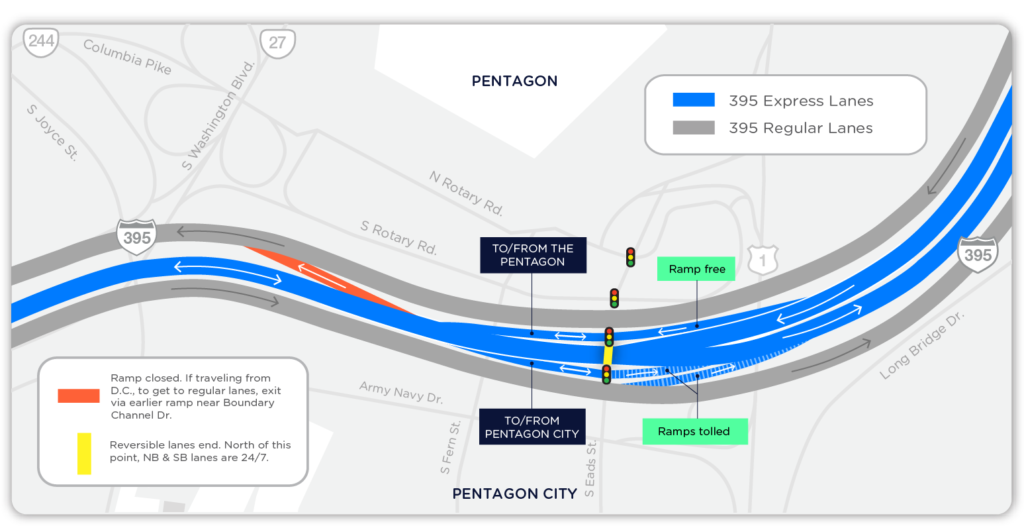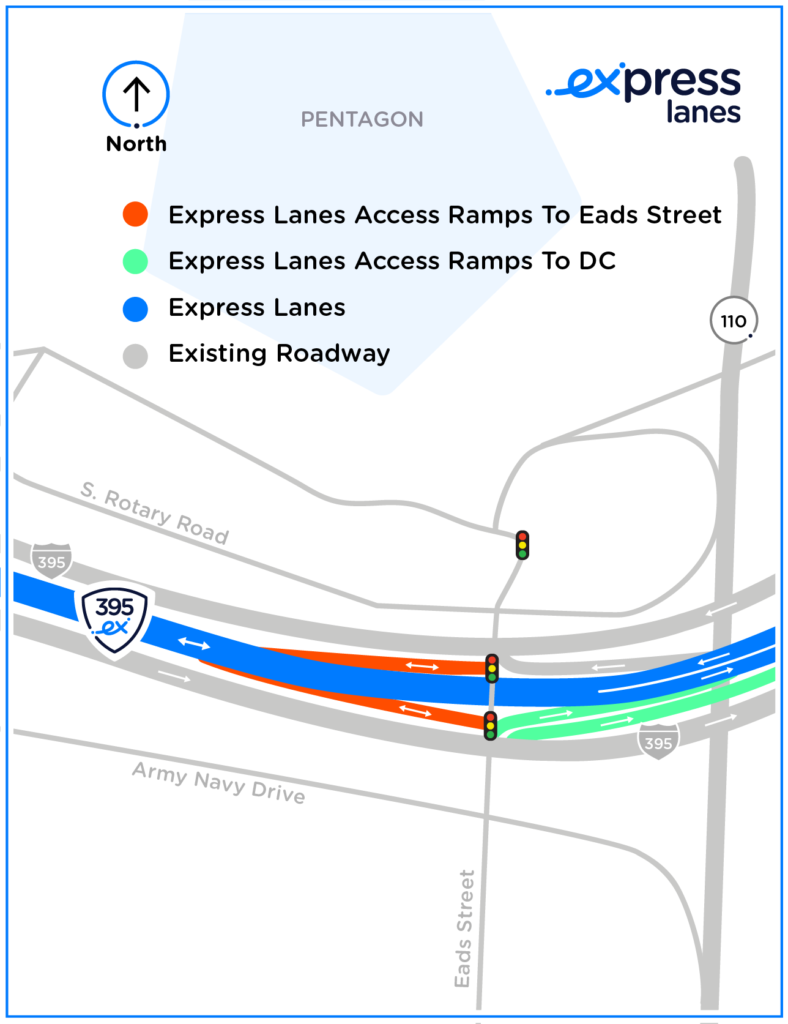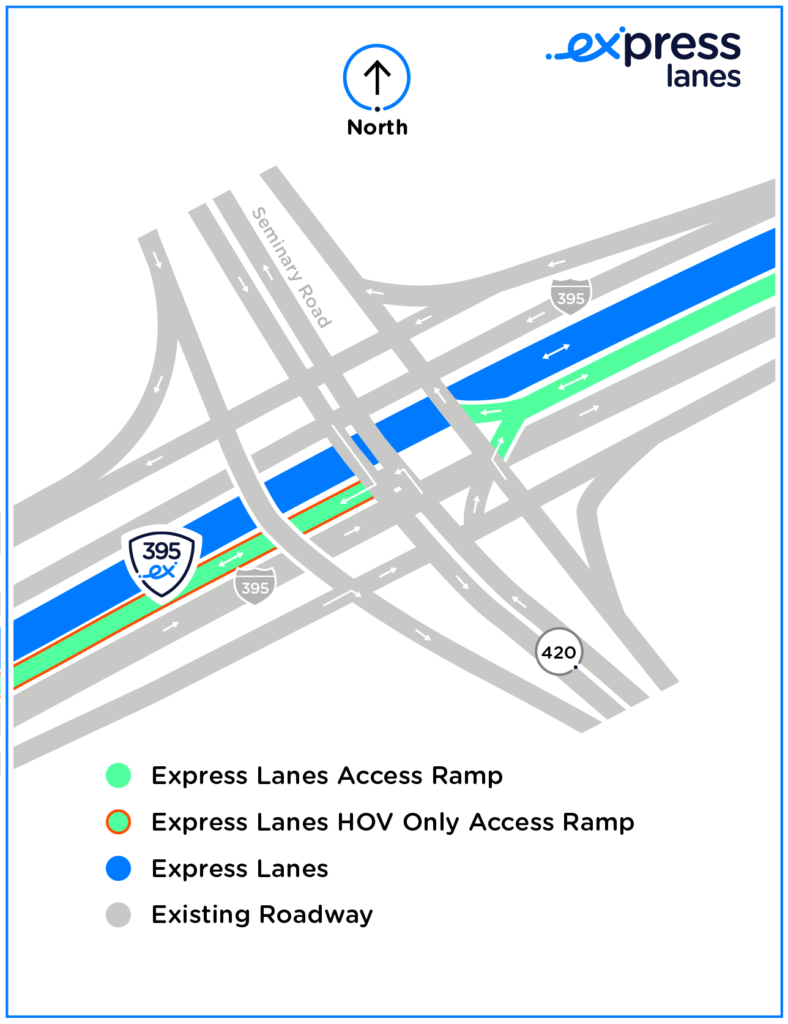Tolls and new High Occupancy Vehicle restrictions are now in place on Interstate 395 from Springfield, Virginia, to the D.C. line.
They started Sunday night.
All drivers using the new 395 Express Lanes are required to have an E-ZPass of some kind. Drivers who use the lanes without an E-ZPass will get a bill in the mail, even if they met carpool requirements.
The two reversible HOV lanes are becoming three HOV or toll lanes in each direction, extending the 95 Express Lanes about 8 miles to the north. The I-395 and I-95 lanes will follow the same reversal schedule they have had in the past, although the reversal could take slightly longer than usual until crews get used to the new operations.
Construction will remain in the corridor to put up new noise walls and do other construction that was folded into the contract, such as an extension of a regular southbound lane between Duke Street and Edsall Road due to open next spring.
Q: How much will they cost?
Drivers with at least two other people in the car can ride free with an E-ZPass Flex, but all others must pay at all times of day, all days of the week.
Transurban, the private company that operates the lanes, expects the average toll paid by those without an E-ZPass Flex in HOV mode will be around $8. The highest prices for the 8-mile stretch are expected to be between $20 and $30 in the early period of operations.
Toll prices can change as frequently as every 10 minutes. The current toll for a short-, middle- and long-distance exit will be displayed on signs as drivers approach the lanes.
The toll calculations and the price shown on overhead signs will only be for the 395 Express Lanes. Travel in the 95 Express Lanes is priced separately for different segments, so a toll-paying driver traveling all the way from the D.C. line to Stafford County (or, in the future, Fredericksburg) would pay for several separate segments.
Most drivers who pay tolls today in the 95 Express Lanes do not travel the length of the corridor, Transurban said, but rather use the lanes for 10 to 12 miles. Average tolls are around $10, but individual trips can be as much as $30 for one segment, Transurban’s Mike McGurk said.
The tolling and HOV rules are the same on the 95 Express Lanes, 495 Express Lanes and 395 Express Lanes. Tolling rules on Interstate 66 inside the Beltway are different for now.
Tolling rules on Interstate 66 outside the Beltway will match the 95, 495 and 395 Express Lanes when the I-66 toll lanes — in each direction between Gainesville and the Beltway — open around the end of 2022.
Q: What’s changing?
At the Pentagon exit/entrance

In addition to the new tolling and expanded HOV rules, the Eads Street interchange at the Pentagon is completely changing. (See above.)
Drivers heading to the Pentagon in the morning will now use the left lane to exit from the Express Lanes. Drivers heading to Pentagon City will use the same right exit ramp as before.
Both ramps will end with new traffic signals at Eads.
For drivers who accidentally use the wrong ramp in the first weeks, there will be some detour signs posted to loop around Army Navy Drive.
Tolling in/out of D.C.
The HOV or tolling rules will apply northbound all the way up to the Potomac River, which includes the ramp from the I-395 regular lanes just after Eads to the center lanes and middle bridge of the 14th Street Bridge complex.

Transurban hopes tolling the entrance from Eads and the entrance to the lanes from the regular I-395 lanes can help limit traffic jams in tolled lanes back past the Pentagon. Because the road ends in D.C., the per-mile tolls for using just those ramps could be significant at times the rest of the Express Lanes are pointed northbound.
The prices could be about $10 just for a fraction of a mile as part of the effort to keep most drivers in the regular lanes, McGurk said, similar to the prices at the southern end of the 95 Express Lanes.
“Our focus there is really trying to mitigate congestion as best we can,” McGurk said.
Southbound drivers can use the center lanes/middle bridge of the 14th Street Bridge complex leaving D.C. without being tolled or meeting HOV rules as long as they exit into the regular I-395 lanes just after entering Virginia using the ramp near Boundary Channel Drive.
Drivers traveling on the left lane of the regular I-395 lanes should be aware that the slip ramp into D.C. before the 14th Street Bridge is now a toll road.
The final chance for southbound drivers to exit the middle lanes before facing HOV or toll rules is Eads (Pentagon/Pentagon City).
Drivers who do carpool north to the Pentagon to drop off riders in the morning or south from the Pentagon after picking riders up in the afternoon can use the last stretch in or out of D.C. for immediately before or after the trip.
Transurban said it would automatically waive tolls for those drivers who have used an E-ZPass Flex in HOV mode then switch it to toll mode. The waiver only applies to drivers who pick up or drop off carpoolers or sluggers using the Eads (Pentagon or Pentagon City) exit who then get back on the Express Lanes at Eads.
Failing to switch the E-ZPass Flex back to toll paying mode would be grounds for police to ticket those drivers though for violating tolling rules.
Q: What stays the same?
Most current access points to and from the HOV lanes remain the same for the Express Lanes, with the same reversal schedule.
The ramp to Seminary Road from the lanes when they are pointed northbound will remain HOV only all the time, with an E-ZPass Flex required. That ramp is also HOV only to enter the lanes from Seminary when the lanes are pointed southbound.
Transurban, the Virginia Department of Transportation and Alexandria officials are looking into changing that.

Q: I got in the lanes by accident. What now?
As drivers get used to the new lanes, Transurban is willing to waive tolls or make other accommodations for drivers who mistakenly get in the lanes.
The company wants to make sure that there are no repeats of the major issues that happened when the 495 Express Lanes opened with drivers trying to stop or back up in the middle of fast-moving traffic.
Drivers can call Transurban at 855-495-9777 to address the issue. There’s also an online form to submit questions or concerns.
Q: I don’t have an E-ZPass Flex, but need to keep carpooling/slugging. What should I do?
For the first few weeks of tolling, Transurban will allow carpoolers to register their license plates for one week of free rides to provide time for getting an E-ZPass Flex.
The transponders can be ordered online or picked up at a number of retail stores in the area.
Temporary carpool registration with Transurban will be permitted through the end of November. Call 855-495-9777.
Q: Can motorcycles ride free?
Like in the 95 and 495 Express Lanes, motorcycles ride free in the 395 Express Lanes.
Motorcycles are not required to have an E-ZPass, but those who do also are not charged for their trips.
Q: Any new transit options?
A number of bus routes currently use the corridor, and Metro and Virginia Railway Express also serve the area. But a sliver of the toll revenue is also going to some new transit options.
OmniRide’s new bus routes from Staffordboro to the Pentagon and L’Enfant Plaza, for example, are free through the end of this year, so riders can try it out.
Q: Who handles enforcement in the lanes?
Virginia State Police will enforce the HOV rules in the toll lanes.
A light flashes on gantries to indicate to troopers which cars are claiming to meet carpool requirements, and troopers can then pull over any violators.
Enforcement locations include the area just before the D.C. line.







